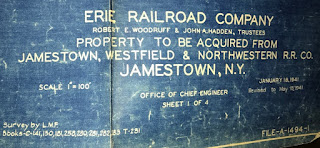by pumpers
Russ, I will gladly let the pro (i.e. you) take the lead on making the edits.
3 last updates:
1. The CT and the JWNW did actually connect in the Factory Rd (E. Campbell Rd) area where the CT went under the JWNW. See the blowup of the Westfield area on this map from the Western NY rail page I linked earlier: http://www.wnyrails.net/railroads/jwnw/jwn_home.htm" onclick="window.open(this.href);return false; I found the original map source somewhere else on the web too, but now I can't find it. I am not sure if the connection was put in after they had a common owner (Broadhead family) fairly late in life or earlier, and what exactly they used it for. With a common owner, they probably would have wanted to swap cars, etc, when needed. One pesky detail - the maps shows the CT going OVER the JWNW, whereas from my earlier post and the official proceedings, it is clear the CT went UNDER. I'll blame that on a map error.
2. I don't think that big building in the old postcard link of the Portage/Main St's intersection in Westfield with the trolleys in front is the Welch Building after all. The size and number of stories is about right, but the shape of windows and trim is completely wrong compared to the modern Welch building,and I did find an old picture of the Welch building looking more or less like it is today. I looked at old Sanborn maps showing outlines of buildings, and now I have no idea what it was in the old postcard link. Suggestions from the local experts?
3. The JWNW ) interchanged with both with LSMS and the NKP over a long period of time, not simply switching from one to the other as I guessed earlier. Here is a 1915 article about the electrification (interesting in itself) that mentions both interchanges in the introduction. http://books.google.com/books?id=y6dMAA ... ge&f=false" onclick="window.open(this.href);return false;
Then here is list of system-wide NKP interchange activity in 1943 showing JWNW interchange in Westfield (and interestingly direct LSMS/NKP interchange as well).http://nkphts.org/1944databooks/nkp/pages/page_6.html" onclick="window.open(this.href);return false; Lots of sites say there was a very active JWNW / NYC(LSMS) interchange right to the end of the JWNW in 1950. So clearly those Sanborn index overview maps shown in the Western NY rails site are incomplete (which I have commonly found to be the case)
3 last updates:
1. The CT and the JWNW did actually connect in the Factory Rd (E. Campbell Rd) area where the CT went under the JWNW. See the blowup of the Westfield area on this map from the Western NY rail page I linked earlier: http://www.wnyrails.net/railroads/jwnw/jwn_home.htm" onclick="window.open(this.href);return false; I found the original map source somewhere else on the web too, but now I can't find it. I am not sure if the connection was put in after they had a common owner (Broadhead family) fairly late in life or earlier, and what exactly they used it for. With a common owner, they probably would have wanted to swap cars, etc, when needed. One pesky detail - the maps shows the CT going OVER the JWNW, whereas from my earlier post and the official proceedings, it is clear the CT went UNDER. I'll blame that on a map error.
2. I don't think that big building in the old postcard link of the Portage/Main St's intersection in Westfield with the trolleys in front is the Welch Building after all. The size and number of stories is about right, but the shape of windows and trim is completely wrong compared to the modern Welch building,and I did find an old picture of the Welch building looking more or less like it is today. I looked at old Sanborn maps showing outlines of buildings, and now I have no idea what it was in the old postcard link. Suggestions from the local experts?
3. The JWNW ) interchanged with both with LSMS and the NKP over a long period of time, not simply switching from one to the other as I guessed earlier. Here is a 1915 article about the electrification (interesting in itself) that mentions both interchanges in the introduction. http://books.google.com/books?id=y6dMAA ... ge&f=false" onclick="window.open(this.href);return false;
Then here is list of system-wide NKP interchange activity in 1943 showing JWNW interchange in Westfield (and interestingly direct LSMS/NKP interchange as well).http://nkphts.org/1944databooks/nkp/pages/page_6.html" onclick="window.open(this.href);return false; Lots of sites say there was a very active JWNW / NYC(LSMS) interchange right to the end of the JWNW in 1950. So clearly those Sanborn index overview maps shown in the Western NY rails site are incomplete (which I have commonly found to be the case)
